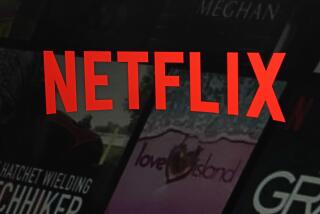Netflix-Comcast deal ends Internet consumption dispute

The landmark deal between Comcast Corp. and Netflix Inc. resolves a simmering dispute over who will support America’s growing Internet video habit.
Netflix has agreed to pay Comcast for a direct connection to the cable operator’s broadband networks to ensure that Netflix customers receive an uninterrupted viewing experience when streaming movies and TV shows.
The agreement, which was confirmed this weekend, comes after Netflix customers complained about deteriorating service, as videos they tried to watch stuttered and stalled in midstream.
The difficulties highlight the increasing problem of Internet network congestion.
PHOTOS: Behind the scenes of movies and TV
Just like the Los Angeles freeways, the nation’s data lines were not designed with enough capacity to handle today’s crush of traffic — particularly during peak hours. Experts for years have been warning about a looming online traffic jam.
A 2012 research paper by Bell Laboratories Inc. cautioned that the growing consumer appetite for online video would overwhelm residential broadband networks in just a few years. Streaming services such as Netflix, the research firm said, would account for nearly half of all video consumption by 2020.
Already, Netflix gobbles up about 30% of Internet traffic during evening hours, and that percentage is expected to swell as more people subscribe to the popular streaming service. The company is undergoing one of the fastest growth spurts in the industry, boasting more than 33 million subscribers in the U.S. — a nearly threefold increase from four years ago.
But video streaming quality had become a problem.
“How can Netflix hope to grow subscribers rapidly if their subscribers who have the largest and most-widely used Internet service provider end up with a poor Netflix experience?” BTIG Research media analyst Richard Greenfield wrote in a research note. “Comcast was willing to use its size and scale to force Netflix’s hand.”
Comcast is the nation’s largest residential Internet service provider, and it is poised to become even bigger.
Graphic: Comcast makes bid to acquire Time Warner Cable
Two weeks ago, Comcast announced its planned $45.2-billion merger with Time Warner Cable, which would give Comcast nearly 30 million pay-TV and Internet service customers.
The Netflix-Comcast agreement shines a light on the obscure world of “peering agreements” that govern how big companies exchange traffic on the Internet.
To improve the quality of its streaming service, Netflix had been commissioning third parties, such as Cogent Communications Inc., to deliver its video traffic across the Internet to Comcast and other Internet providers. But Netflix wanted to cut out the middleman and deal directly with Comcast.
FACES TO WATCH 2014: Digital media
Initially, Netflix argued that it should be allowed to install its own servers inside Comcast’s network to provide smoother traffic connections. But Comcast said no, arguing that Netflix should help shoulder the cost of delivering additional traffic to its networks since it was the heavy consumption by Netflix customers that was causing strain to the system.
After several months of negotiations, Netflix agreed to pay for direct lanes into Comcast’s vast networks.
Google Inc., Amazon.com Inc. and Yahoo Inc. already pay for such access to broadband providers like Comcast.
“It’s actually a fairly major moment for the Internet, for Netflix to give up and start paying,” said Marvin Ammori, an Internet policy expert. “Netflix was a major holdout.”
Comcast had reasons to hammer out an agreement with Netflix. Comcast is preparing for a lengthy review by the U.S. Department of Justice and the Federal Communications Commission to win approval to buy Time Warner Cable.
Observers believe that government regulators might raise concerns about Comcast’s increased market power, particularly when it comes to preserving open access to the Internet. Comcast will have to persuade regulators that it will not use its increased heft to squeeze competitors or content providers such as Netflix. Some have argued that Comcast could point to the Netflix deal to show that it doesn’t need further intervention.
Others are not so sure.
“This is a game-changing development,” said Comcast critic Susan Crawford, a visiting professor at Harvard Law School and author of the book “Captive Audience: The Telecom Industry and Monopoly Power in the New Gilded Age.”
“It shows that carriers such as Comcast and Verizon can use the control over their physical networks to extract payments from connecting networks,” Crawford said. “This is not about paying them back for the investments they have made in their networks. That was paid for a long time ago. This is an exploitation of their physical control over ingress into their networks. It means they can set whatever price they want for connecting to their networks.”
As recently as last fall, Netflix Chief Executive Reed Hastings told investors that his company’s customers were already paying their Internet providers for high-speed connections into their homes.
The broadband companies collect $40 to $60 a month per subscriber for that high-speed Internet service, he said, adding that Netflix should not have to further subsidize the delivery of the content.
But BTIG’s Greenfield wrote that Netflix probably recognized that Comcast, with about 20 million broadband Internet subscribers, was too important a partner to allow the problems to fester. Comcast could have weathered the storm, but it would have been more difficult for Netflix, he said.
“With the prospect of Comcast buying Time Warner Cable, we suspect Netflix knew it was time to cut a deal with Comcast,” Greenfield wrote.
More to Read
From the Oscars to the Emmys.
Get the Envelope newsletter for exclusive awards season coverage, behind-the-scenes stories from the Envelope podcast and columnist Glenn Whipp’s must-read analysis.
You may occasionally receive promotional content from the Los Angeles Times.










